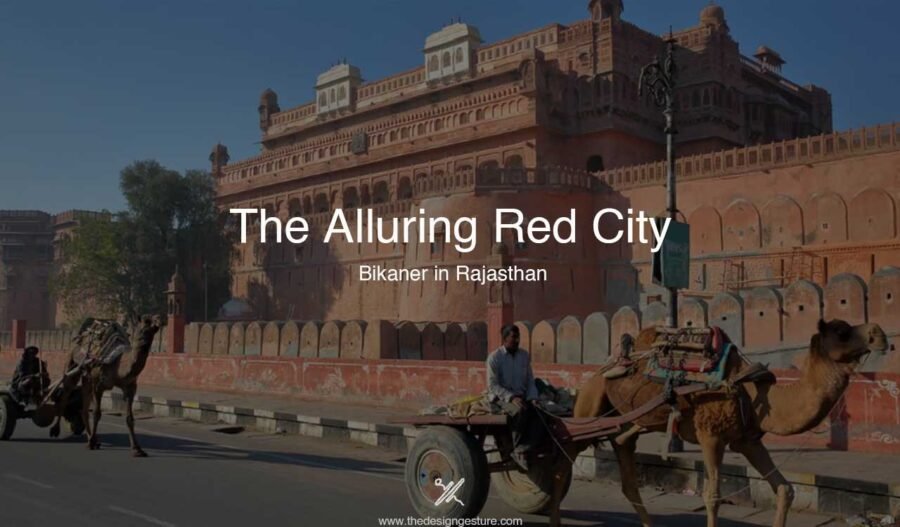The dynamic and bustling city of Bikaner in Rajasthan is surrounded by a wide expanse of golden undulating dunes, making it an off-the-beaten-path tourist attraction. This ancient city, tucked away in the Thar desert, is visited by thousands of visitors each year who are drawn by its enormous and magnificent forts and palaces. When Rao Bika, the ruler of the Rathore dynasty, governed the area in 1488, the old part of the city stood as a mute testament to the area’s rich history. Enclosed by towering stone walls, the city’s historic district is a kaleidoscope of customs and traditions. You enter a maze of pathways sprinkled with charming brilliant red and yellow sandstone through five enormous gates.
Table of Contents
History of Bikaner in Rajasthan
Under the regiment of Rajput until the 15th Century, Bikaner was known as Jangladesh. The city was established in 1488 by Rao Bika, son of Maharaja Rao Jodha. As he wished to build his kingdom, Bikaner got its name. Bikaner was the oasis in the trade route between central Asia and the Gujarat coast.
Roughly a century after Rao Bika established Bikaner, the area experienced prosperity during the reign of Rai Singhji, the sixth Raja. Rai Singh recognized the Mughals’ suzerainty throughout their dominion over the nation and had a prominent position as an army general in the courts of Emperor Akbar and his son, Emperor Jahangir. His military prowess, which included capturing part of the Mewar kingdom for the empire, brought him praise and benefits from the Mughal rulers. His expertise in art and architecture, which he gained from his travels outside, is evident in the many monuments he constructed in the Bikaner Junagarh fort.
Architecture and Construction
The architecture of Bikaner in Rajasthan is indeed splendid and comprises Jain temples, majestic forts, and beautiful gardens which are constructed in the Rajput style of architecture. Understanding the fortified structures of the place, most were constructed with defensive features and massive gates and bastions. One of the known fortified structures is Junagarh Palace. The palace is known for its architectural detailing and ornamentation. The plan is a simple rectangular plan with all structures out of marble and sandstone.
Bikaner Junagarh Fort
Bikaner Junagadh Fort is a magnificent example of Rajput building design. The fort’s perimeter is more than a kilometer long. There is a sizable courtyard at the entryway that leads to numerous other courtyards and entrances. This design element protects the homeowners’ privacy while also acting as a barrier against adversaries.
The Junagadh Fort is a huge fort with a rectangular layout measuring 986 meters in perimeter length. The walls measure 4.4 meters broad and 12 meters high. Although the moat no longer exists, the fort is ringed by an approximately 7.6-meter-deep moat. The fort also contains seven gates, as well as various palaces, pavilions, Hindu and Jain temples.
The main character is carved from red sandstone. The interior is decorated with traditional Rajasthani artwork. The fort is a combination of many architectural styles, including Rajput, Gujarati, and Mughal.
Besides forts and palaces, havelis are also known as traditional Indian mansions. The havelis have a distinctive character with façade intricate, courtyards, and various culturally rich frescoes. Additionally, temples also have a very distinctive language with stone-carved language.
Karni Mata Temple
The Karni Mata Mandir in Bikaner Rajasthan is well-known for housing over 25,000 rats that roam freely throughout the complex of temples, rather than for its geographical location or architectural style. These critters are visible arising from cracks in the walls and flooring, frequently crossing the feet of guests and worshippers. Eating food that these rats have nibbled on is considered a religious ritual here. In addition to traveling from all over India and the world to see this incredible show, visitors often bring milk, candies, and other offerings for these revered creatures. White rats are particularly revered above all other rats since it is thought that they are the avatars of Karni Mata and her sons.
Maharaja Ganga Singh of Bikaner Rajasthan built the Karni Mata temple during the 1800s. Its layout and construction are reminiscent of Mughal architecture. Historical marvels are the imposing silver doors and captivating marble front. Because of the Taj Mahal’s entryway, which is adorned with fascinating details carved out of marble, you will be reminded of its intricate design, carvings, and construction.
Bhandasar Jain Temple
The three-story Bhandasar Jain Temple is well-known for its exquisite frescoes, mirrored work, and leaf paintings. Red sandstone with exquisite paintings and yellow stone carvings on the walls, sanctum pillars, and mandapa were used in the construction of this temple. There are pictures on the walls that show the lives of the 24 tirthankaras.The garbhagriha, antarala, mahamandapa, and ardhamandapa temples make up the complex. The pancharatha (five rathas) sanctuary is encircled by a shikhara with amalakas and karna-amalakas perched on top.
Along with influences from the British colonial era, Bikaner’s architecture also shows elements of the British Raj, especially in the design of its public buildings and administrative buildings. Ultimately, spanning centuries of history and including a variety of architectural styles and traditions, Bikaner’s architecture is a rich tapestry of cultural influences.
FAQ
1. What are the different architectural styles found in Bikaner Rajasthan?
Bikaneri architecture is a fascinating blend of Rajputana, Mughal, and Jain influences. The Rajput style is evident in the massive forts and palaces with red sandstone exteriors, intricate latticework (jalis), and grand courtyards. Mughal influences can be seen in the use of bulbous domes, geometric patterns, and delicate floral motifs. Jain temples showcase intricate marble carvings and pillared halls.
2. What are some of the most famous forts and palaces in Bikaner?
- Bikaner Junagarh Fort: A majestic fort showcasing Rajput military architecture with seven bastions, orients, and a moat.
- Lalgarh Palace: A stunning red sandstone palace adorned with Mughal-inspired gardens, courtyards, and pavilions.
- Karan Mahal: A beautiful palace known for its intricate latticework windows (jalis), mirror work, and a unique blend of Rajput and Mughal styles.
3. Which is the heritage building of Bikaner?
Bikaner House is a world-class cultural facility housed in a heritage structure near the renowned India Gate hexagon. It was built as a palace for the Maharaja of Bikaner and has been extensively restored.
4. Why is Bikaner in Rajasthan known as red city?
Bikaner, Rajasthan is known as the “Red City” due to its red sandstone havelis. It’s also known as the “City of Havelis” because of its palaces and forts built from red sandstone that have withstood the passage of time.




